| dc.contributor.author | Apon, Tasnim Sakib | |
| dc.contributor.author | Chowdhury, Mushfiqul Islam | |
| dc.contributor.author | Reza, MD Zubair | |
| dc.contributor.author | Datta, Arpita | |
| dc.contributor.author | Hasan, Syeda Tanjina | |
| dc.date.accessioned | 2021-09-03T12:37:44Z | |
| dc.date.available | 2021-09-03T12:37:44Z | |
| dc.date.copyright | 2021 | |
| dc.date.issued | 2021 | |
| dc.identifier.other | ID 20241068 | |
| dc.identifier.other | ID 17101120 | |
| dc.identifier.other | ID 17101275 | |
| dc.identifier.other | ID 18341008 | |
| dc.identifier.other | ID 17101184 | |
| dc.identifier.uri | http://hdl.handle.net/10361/14967 | |
| dc.description | This thesis is submitted in partial fulfillment of the requirements for the degree of Bachelor of Science in Computer Science and Engineering, 2021. | en_US |
| dc.description | Cataloged from PDF version of thesis. | |
| dc.description | Includes bibliographical references (page 48). | |
| dc.description.abstract | Crime rate is increasing proportionally with the increasing rate of the population.
The most prominent approach was to introduce Closed-Circuit Television (CCTV)
camera-based surveillance to tackle the issue. Video surveillance cameras have added
a new dimension to detect crime. Several research works on autonomous security
camera surveillance are currently ongoing, where the fundamental goal is to discover
violent activity from video feeds. From the technical viewpoint, this is a challenging problem because analyzing a set of frames, i.e., videos in temporal dimension
to detect violence might need careful machine learning model training to reduce
false results. This research focused on this problem by integrating state-of-the-art
Deep Learning methods to ensure a robust pipeline for autonomous surveillance for
detecting violent activities, e.g., kicking, punching, and slapping. Initially, we designed a dataset of this specific interest, which were 600 videos (200 for each action).
Later, we have utilized existing pre-trained model architectures to extract features,
followed by classification and accuracy analysis.Also, We have classified our models’ accuracy, confusion matrix on different pre-trained architectures like VGG16,
InceptionV3, ResNet50 and MobileNet V2. Among the pre-trained models VGG16
and MobileNet V2 performed better. | en_US |
| dc.description.statementofresponsibility | Tasnim Sakib Apon | |
| dc.description.statementofresponsibility | Mushfiqul Islam Chowdhury | |
| dc.description.statementofresponsibility | MD Zubair Reza | |
| dc.description.statementofresponsibility | Arpita Datta | |
| dc.description.statementofresponsibility | Syeda Tanjina Hasan | |
| dc.format.extent | 48 pages | |
| dc.language.iso | en | en_US |
| dc.publisher | Brac University | en_US |
| dc.rights | Brac University theses are protected by copyright. They may be viewed from this source for any purpose, but reproduction or distribution in any format is prohibited without written permission. | |
| dc.subject | Deep Neural Network | en_US |
| dc.subject | Deep learning | en_US |
| dc.subject | Real Time Action | en_US |
| dc.subject | Action Detection from Footage | en_US |
| dc.subject | Crime Detection from Footage | en_US |
| dc.subject | Surveillance action detection | en_US |
| dc.subject.lcsh | Deep Learning | |
| dc.title | Real time action recognition from video footage | en_US |
| dc.type | Thesis | en_US |
| dc.contributor.department | Department of Computer Science and Engineering, Brac University | |
| dc.description.degree | B. Computer Science | |

